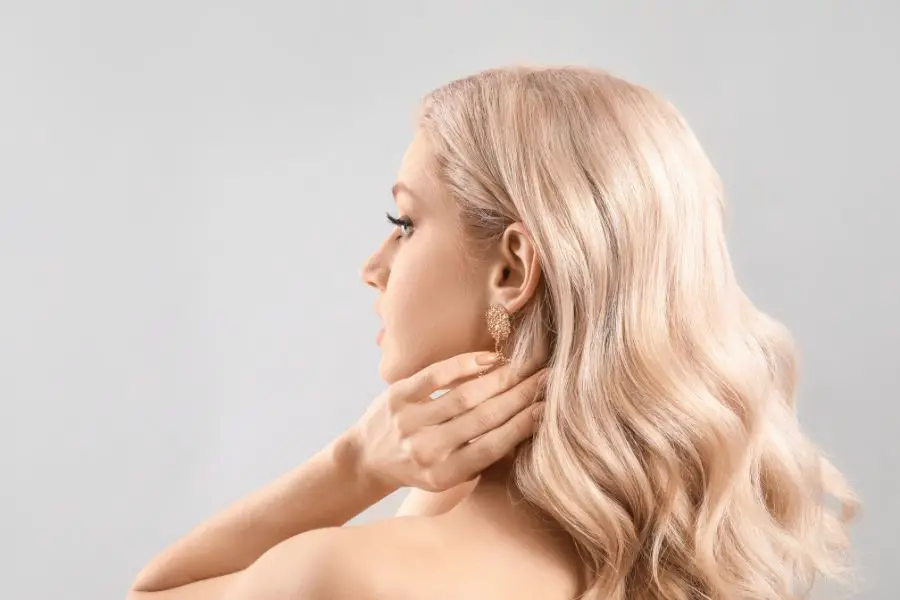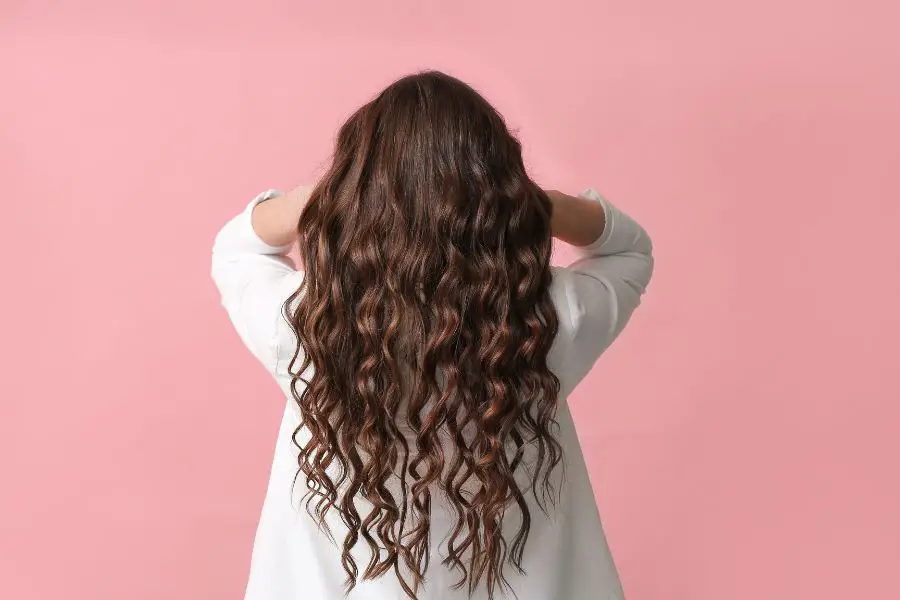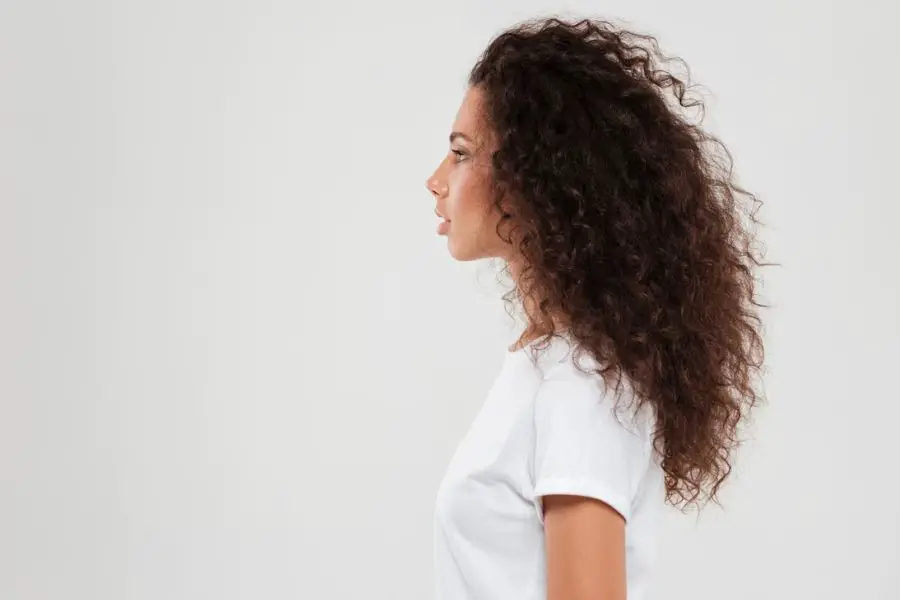Wavy and straight hair are the two most common hair types. Yet, it is difficult for many to figure out which one they have.
Some people have straight hair that turns wavy when wet. Some people get wavy hair when they get older.
In this article, we’ll help you figure out what hair type you have, and show you the exact differences between straight and wavy hair.
The 4 Hair Types
The first step to understanding your hair, is to understand the four types of hair:
- Straight (Type 1)
- Wavy (Type 2)
- Curly (Type 3)
- Coily (Type 4)
Straight Hair Features

Straight hair is known for its basic and plain appearance. It is the most natural hair texture, with no curls or waves. The hair strands lay completely flat and maintain a consistent shape.
Straight hair tends to have more shine than other hair types because natural oils can travel easily down its length.
This type of hair generally requires less maintenance than other hair types.
Learn more: All About Type 1 Hair
Wavy Hair Features

Wavy hair is characterized by a gentle “S” shape in its strands. Its natural texture lies between straight and curly hair. Wavy hair may have some shine but is typically less oily than straight hair.
The curl pattern in wavy hair is not as defined, making it look more relaxed and easygoing.
Curly Hair Features

Curly hair has a more distinct curl pattern compared to wavy hair. The strands of curly hair form tight, well-defined “S” or spiral shapes, which can vary from loose to tight curls.
Curly hair tends to be drier than straight or wavy hair because natural oils find it more challenging to travel down its length due to the curls.
You need to use specific products to maintain your hair’s natural texture and curl patterns.
Coily Hair Features

Coily hair, also known as kinky hair, is the most tightly coiled of all hair types. The strands of coily hair form tight, spring-like coils or zigzag patterns.
This hair type is more prone to dryness and breakage due to its natural texture. This makes it essential to provide proper care and moisture.
Coily hair needs special products to maintain and enhance its unique curl patterns.
Differences Between Straight and Wavy Hair
The main differences between straight and wavy hair are the shape, styling, and maintenance of each hair type:
- Shape: Straight hair falls flat, while wavy hair has an S-shaped curve
- Styling: Straight hair struggles with holding curls, while wavy hair offers more versatility
- Maintenance: Straight hair requires more frequent washing, while wavy hair benefits from moisturizing products.
Shape
Straight hair (Type I) falls smoothly from the roots to the ends. It’s known for being low-maintenance, but it can also lack volume. Straight hair tends to be more oily since the natural oils from the scalp can easily reach the hair strands.
In contrast, wavy hair (Type II) has a gentle, S-shaped curve from the midpoint to the ends. It sometimes appears straight at the top. Wavy hair may be more prone to frizziness and needs extra care to be kept smooth and tangle-free.
Styling
Styling also differs between these hair types.
Straight hair often doesn’t hold curls well, while wavy hair can create a variety of looks including beachy waves and soft, romantic styles.
Maintenance
When it comes to maintenance, straight hair needs more washing due to oil buildup. Wavy hair benefits from moisturizing products to fight frizz.
Is Your Straight Hair Actually Wavy?
Sometimes, what seems to be straight hair hides wavy or curly patterns. Here are some signs that can help you determine whether your seemingly straight hair is actually wavy or curly:
Signs That Straight Hair Is Actually Wavy Or Curly
- Wavy when wet: Your hair appears wavy when it’s wet but dries straight.
- Poofy or fluffy: Your hair tends to look poofy or fluffy, especially when it’s humid.
- Flipped ends: The ends of your hair flip in or out, instead of lying perfectly straight.
- Frizziness: Your hair may be prone to frizziness, especially in humid conditions.
- Thickness and puffiness: Your hair gets thick and puffy when cut short.
- Shrinkage: When cut wet, your hair ends up shorter than intended after drying.
- Bends or twists: Instead of being pin-straight, your hair occasionally has bends or twists in it.
Can Your Hair Change From Straight to Wavy?
Yes, your hair can transition from straight to wavy. Hormonal changes, aging, and lifestyle factors like stress can influence this transformation. Specific hair care products and tools can also make straight hair turn wavy.
How to Determine Your Hair Type

Now that you know the difference between the hair types, here’s how you can find yours:
Hair Texture
To figure out your hair texture, you need to know about the four main categories:
- Straight (Type 1)
- Wavy (Type 2)
- Curly (Type 3)
- Coily (Type 4)
Each hair type has subcategories (A, B, and C) for more specific characteristics.
To determine your hair texture, look at your hair’s natural shape and curl pattern without any styling products.
Hair Structure
Hair structure refers to the thickness of your hair strands.
To identify if your hair is thin or thick, take a single hair strand from your brush, and place it on a flat surface. Cut a 6-inch long piece of sewing thread and put it next to the hair strand.
If your hair is thicker than the thread, it’s considered thick. If it’s the same or thinner, your hair is thin.
Hair Porosity
Hair porosity refers to how well your hair absorbs and retains moisture.
To find out your hair porosity, try the float test:
- Collect a clean, dry strand of hair from your brush or comb.
- Fill a glass with water.
- Place the hair strand into the water and let it sit for 2-3 minutes.
- Observe if the hair floats or sinks.
Here’s what it means:
- Floating hair: Low porosity (struggles to absorb moisture)
- Sinking hair: High porosity (easily absorbs and loses moisture)
- In-between: Normal porosity (balanced absorption and retention)
Scalp Moisture
Your scalp’s moisture levels can affect your hair type since it determines how well your hair is nourished and maintained.
To check your scalp’s moisture levels, examine your hair and scalp after not washing it for a day or two (make sure you’re not using any hair products):
- If your scalp feels oily or greasy, you have a high moisture level.
- If your scalp feels dry or itchy, it has a lower moisture level.
- If it feels neither oily nor dry, your scalp has a balanced moisture level.
Hair Care Essentials
As the hair types are different, so is the care they need:
Hair Care for Straight Hair
Straight hair tends to become oily faster, so avoid heavy products that can cause buildup. Instead, use lightweight products.
Straight hair care starts with the right shampoo and conditioner. Opt for products that are sulfate-free, as sulfates can strip natural oils from your hair.
Wash your hair regularly, but be careful not to overdo it as it can lead to dryness. After washing, apply a lightweight leave-in conditioner or serum to keep your hair moisturized and smooth.
Hair Care for Wavy Hair
Wavy hair requires a balance between moisture and volume. It benefits from hydrating shampoos and conditioners, but avoid silicones as they weigh hair down.
Use a leave-in conditioner or cream to seal in moisture and avoid frizz. Scrunch your waves gently while applying the product for better definition. Diffuse your hair on a low heat setting or allow it to air dry for natural-looking waves.
You should also use a wide-tooth comb to detangle your hair to prevent breakage and frizz.
Common Hair Issues
Straight Hair Issues
Straight hair might seem low-maintenance, but it’s not immune to issues.
One common problem is flatness, as straight hair can often appear lifeless and weighed down. To combat this, use volumizing products and avoid applying heavy conditioners on the roots.
Another common issue is frizziness. Even though straight hair is often glossy and shiny, humidity and damage from heat styling cause frizz. To reduce frizziness, use a serum or oil to protect your strands when using heat-styling tools.
Lastly, straight hair is prone to breakage and split ends because the hair is fine. To counteract this, use moisturizing treatments and get frequent trims.
Wavy Hair Issues
Wavy hair comes with its own unique set of concerns.
One major challenge is maintaining consistency in curl pattern. Wavy strands can appear uneven, with areas of straight, wavy, or poofy hair. To help, use curl-enhancing hair products and scrunch your hair while it’s wet.
Frizz is a common issue for wavy hair as well. To tackle frizziness, avoid over-washing your hair. This strips your hair of its natural oils.
Instead, use sulfate-free shampoos and gentle conditioners to preserve moisture. Incorporate leave-in products like creams and gels to provide additional hydration and hold for your waves.
Lastly, wavy hair can experience breakage and split ends similar to straight hair. Regular trims and deep conditioning treatments help maintain healthy, strong hair.
Additionally, avoid brushing your hair when it’s dry, as this can cause further damage.
Styling Your Hair

Last, but not least, you need to know how to style your hair. Different hair types benefit from different styling techniques:
Straight Hair Styling Tips
To style your straight hair, try different hairstyles to achieve a more voluminous look.
For example, you can create beachy waves by applying a texturizing spray and using a curling iron to create loose, tousled waves.
Another option is to add soft layers for a natural, dimensional appearance. Use lightweight styling products such as mousse or volumizing spray to achieve a fuller look without weighing your hair down.
Remember to use a heat protectant spray before using any heat styling tools to keep your hair healthy.
Wavy Hair Styling Techniques
Embracing your wavy hair can be exciting and fun as it offers versatility with its natural S shape.
You can create defined waves by using a curling iron or a flat iron to enhance your hair’s natural texture. Again, make sure to use a heat protectant spray to minimize heat damage.
For a more casual and effortless look, try creating beachy waves by scrunching your damp hair with a light hold gel or foam. You can also experiment with different braids to achieve a variety of wavy styles.
FAQs
How To Tell If My Hair Is Straight Or Wavy?
Determining whether your hair is straight or wavy is simple. After washing, observe your hair as it dries: if it lies flat, it’s straight. If you see waves, it’s wavy.








